Mass Effect: Andromeda PC performance analysis
A new engine and a new galaxy demand more from your hardware.
After five years a new Mass Effect is here, and a whole lot has changed since BioWare made Mass Effect 3. It's switched from Unreal Engine 3 to the DICE Frostbite 3 engine used for Battlefield 1 and Dragon Age: Inquisition. With Frostbite 3, Mass Effect is running on a modern graphics engine—it's a major jump in technology, although currently Mass Effect is missing the DirectX 12 support that Battlefield 1 has with Frostbite.
Mass Effect: Andromeda's environments range from dense psychedelic rainforests to sterile rocky plains that stretch out into gorgeous mountain vistas, all set against skyboxes that'd make Sagan shed a happy tear—it looks amazing, character animations at times notwithstanding. The huge draw distances populated with outposts, vegetation, enemies, and fauna take a lot of graphics horsepower to run. Being something of an open world game, the engine is going to behave differently from a Battlefield game. And by that, I mean it's going to run slower than Battlefield 1—sometimes framerates are even lower by half.

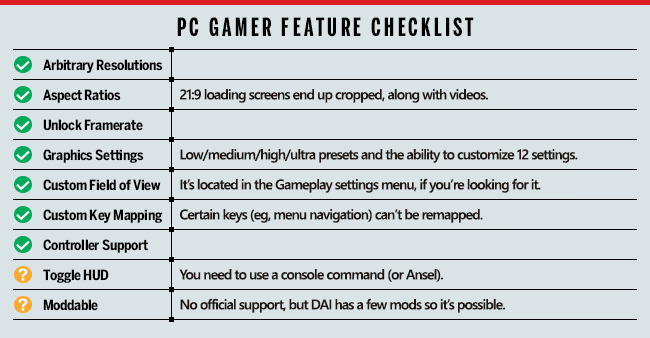
Swipe left/right for more.

Swipe left/right for more.
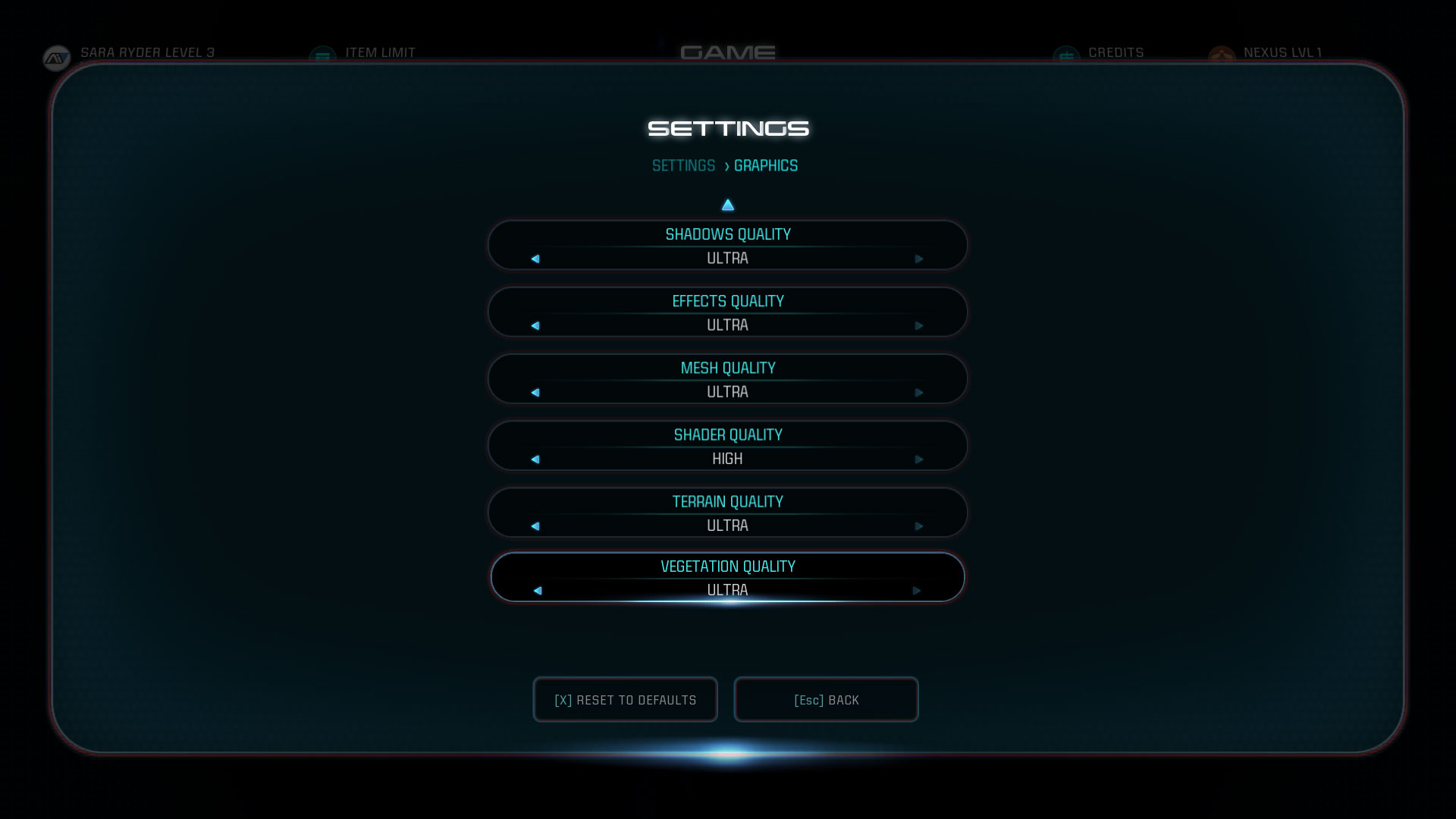
Swipe left/right for more.
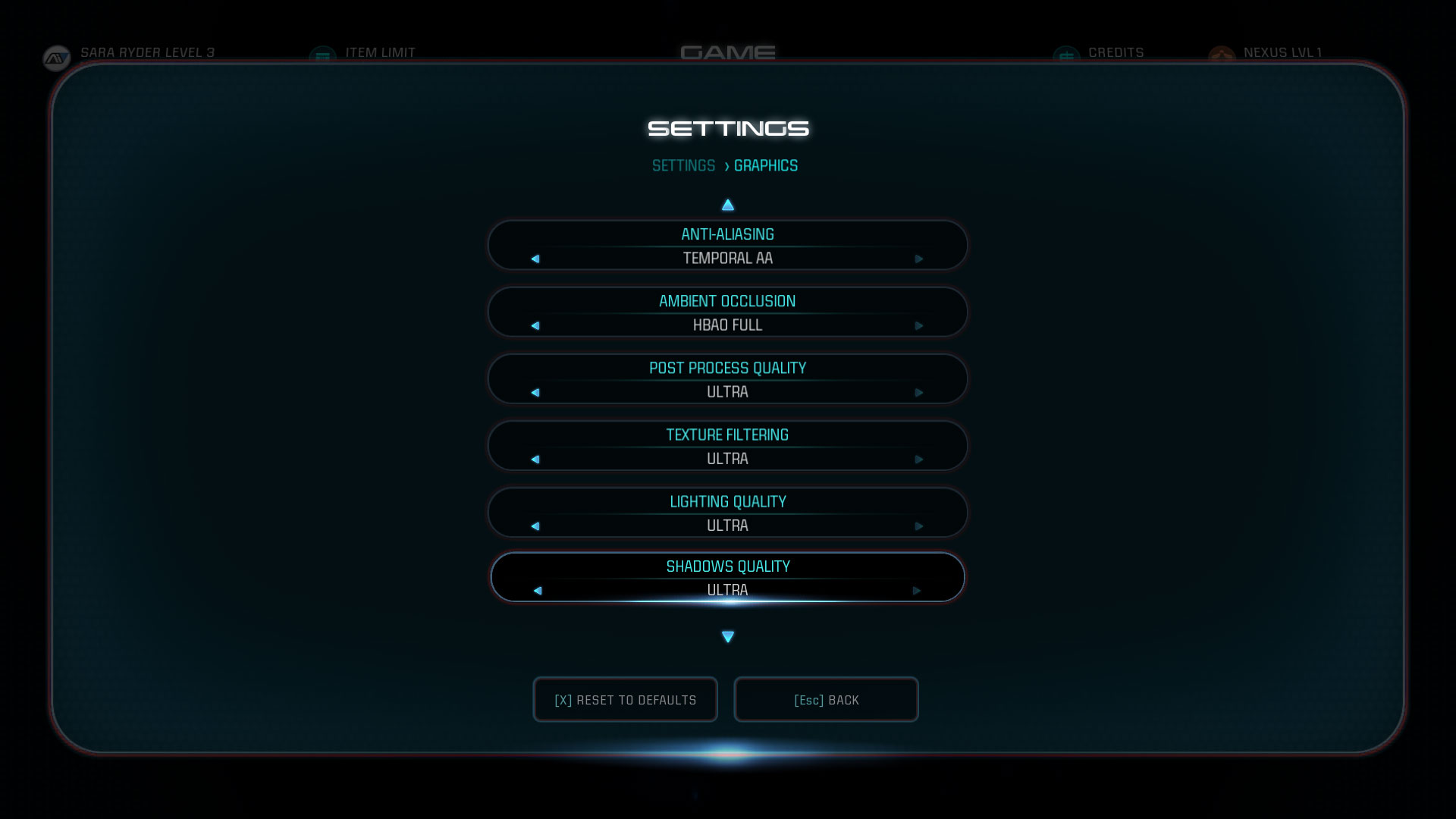
Swipe left/right for more.
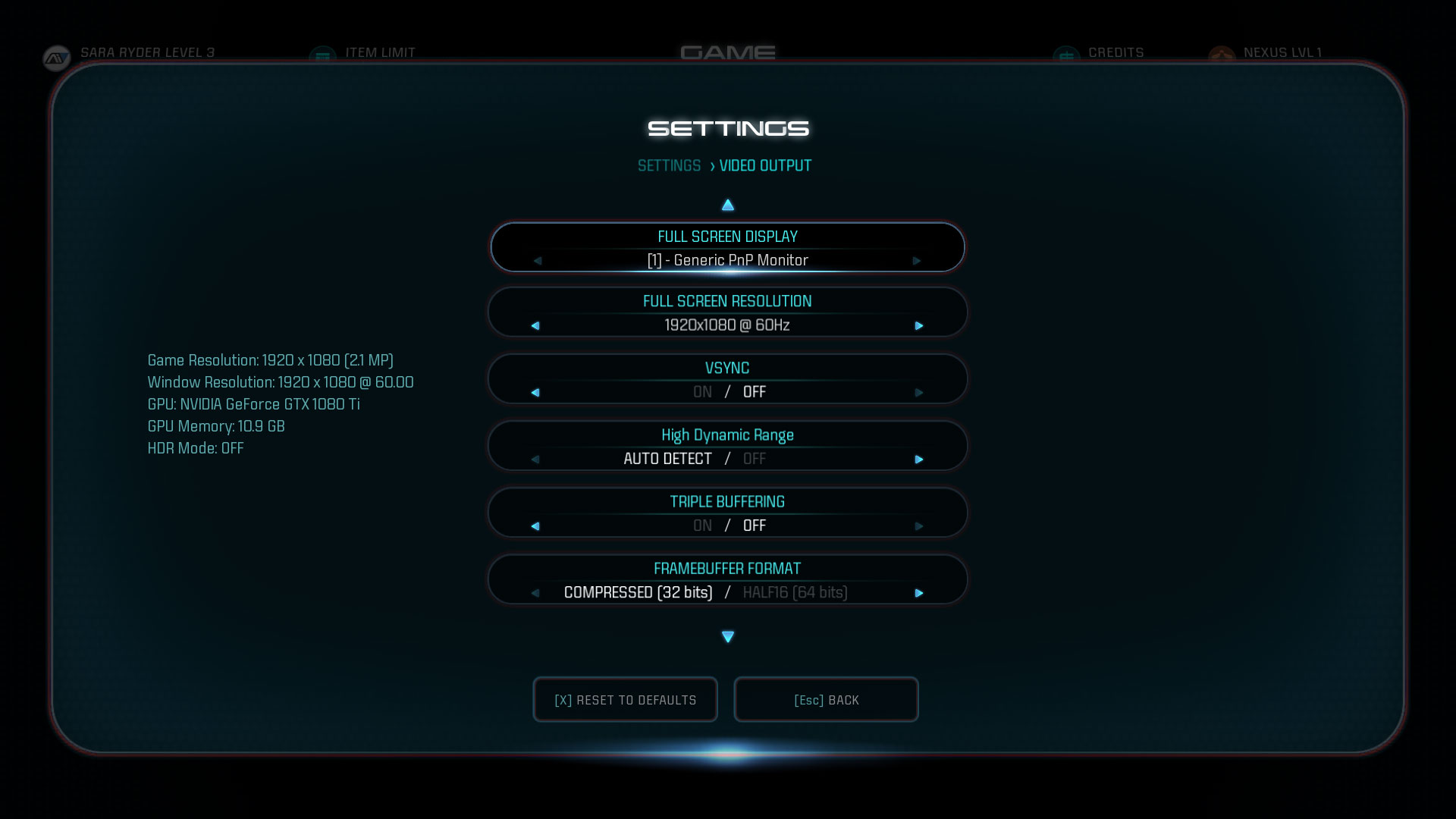
Swipe left/right for more.
Quickly running through the features and settings options, Andromeda covers most of the bases. Resolution support is good, though at ultrawide resolutions the loading screens are cropped. FOV adjustment are available, though the setting is strangely located under the 'gameplay' menu rather than in the video or graphics settings, and the FOV automatically changes to accommodate ultrawide displays. Mods are unfortunately not likely to be a major undertaking, at least not initially, but Dragon Age Inquisition did end up with some community hacking opening things up, so there's hope.
As far as the settings go, you can see the various video and graphics options in the top gallery, while this gallery shows how the game looks at each setting. There are four presets, low, medium, high, and ultra, plus the custom option that opens everything up. While low represents the minimum quality on all the options, even the ultra setting doesn't quite max things out—HBAO full for example isn't enabled—and I've included that, along with an ultrawide screenshot, as the 'max' quality.
Note that everything below the ultra preset by default uses resolution scaling—1080p for high, 900p for medium, and 720p for low—so if you use one of those presets you won't actually get the resolution you set. Unless you choose to then customize the setting and disable resolution scaling, which is what I did for the testing.
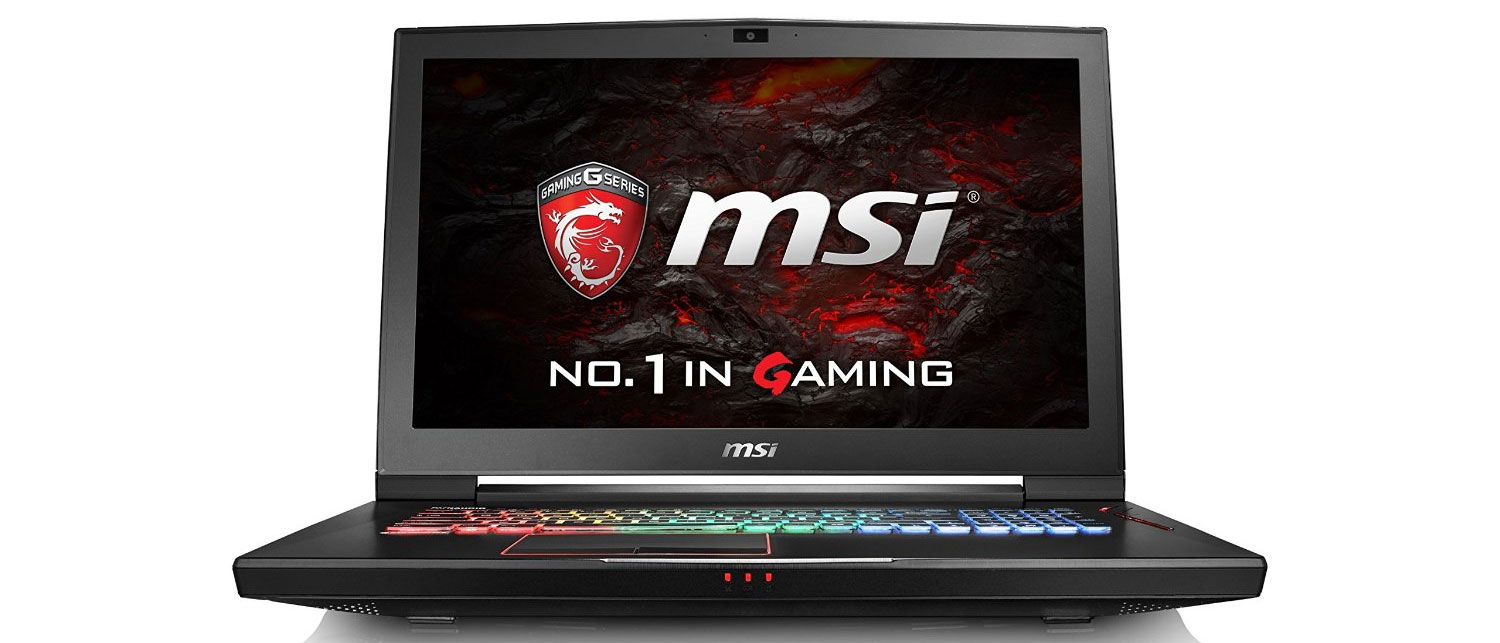
As our partner for these detailed performance analyses, MSI provided the hardware we needed to test Mass Effect: Andromeda on a bunch of different AMD and Nvidia GPUs and laptops. Full details of our test equipment and methodology are detailed in our Performance Analysis 101 article. Thanks, MSI!
Today we're going to be showing some benchmarks of Andromeda from a sequence we ran on the planet Eos, one of the more demanding areas early in the game. But keep in mind Andromeda is a huge game with open world combat and exploration, so performance can and will vary. Expect significantly higher framerates on ships and space stations, for example.
For parts of the game like Eos, entry-level cards like the GTX 1050 and RX 460 will handle 1080p medium, and even then you're not going to get a full 60 frames per second. Move up to the next level with the GTX 1060 and RX 470 and you'll be able to run 1080p ultra, but you'll still see drops below 60 fps unless you tweak some settings. 1440p ultra will need a GTX 1080 or higher for 60 fps, though the 1070 comes close. And if you demand 4K at 60 frames per second, you're going to want at least a GTX 1080, and probably a 1080 Ti—and then drop some of the settings to medium/high.
Keep up to date with the most important stories and the best deals, as picked by the PC Gamer team.

Along with the usual suite of benchmarks and analysis, we're also providing something new: real-time framerate comparisons via video. We have a framerate overlay chart with a selection of likely candidate GPUs at each setting. If you want to see more of what each setting looks like and how it runs, check it out.
MSI provided all of the hardware for this testing, mostly consisting of its Gaming/Gaming X graphics cards, which were very quiet during our benchmarking—fan noise is never a serious issue and the fans will even shut off completely when the graphics card isn't being used.
Our main test system is MSI's new Aegis Ti3, a custom case with an overclocked 4.8GHz i7-7700K, 64GB RAM, and a pair of 512GB Plextor M8Pe M.2 NVMe solid-state drives in RAID0. There's a 2TB hard drive as well—not that I used it when I had a fresh 1TB SSD array waiting to be filled. (Note: due to various constraints, the 1080 Ti was tested on my normal GPU testbed, which uses an overclocked i7-5930K.)
For drivers, I tested Nvidia with 378.78 and AMD with 17.3.2. Nvidia has now released the 378.92 drivers, but I spoke with Nvidia reps last week and they indicated there should be no difference in single GPU performance. SLI on the other hand will work properly with the newer drivers, which is something I'll look at soon. I did retest 1080 Ti performance with the new drivers and saw no significant changes.
MSI also provided three of its gaming notebooks for testing, the GS63VR with GTX 1060, GT62VR with GTX 1070, and GT73VR with GTX 1080. Unfortunately, our early access press account didn't allow us to run the game on more hardware combinations, but I've added gaming notebook results below. (If you're wondering, the retail release appears to lock you out of the game if you 'play' it on more than four hardware combinations in a 24 hour period.)
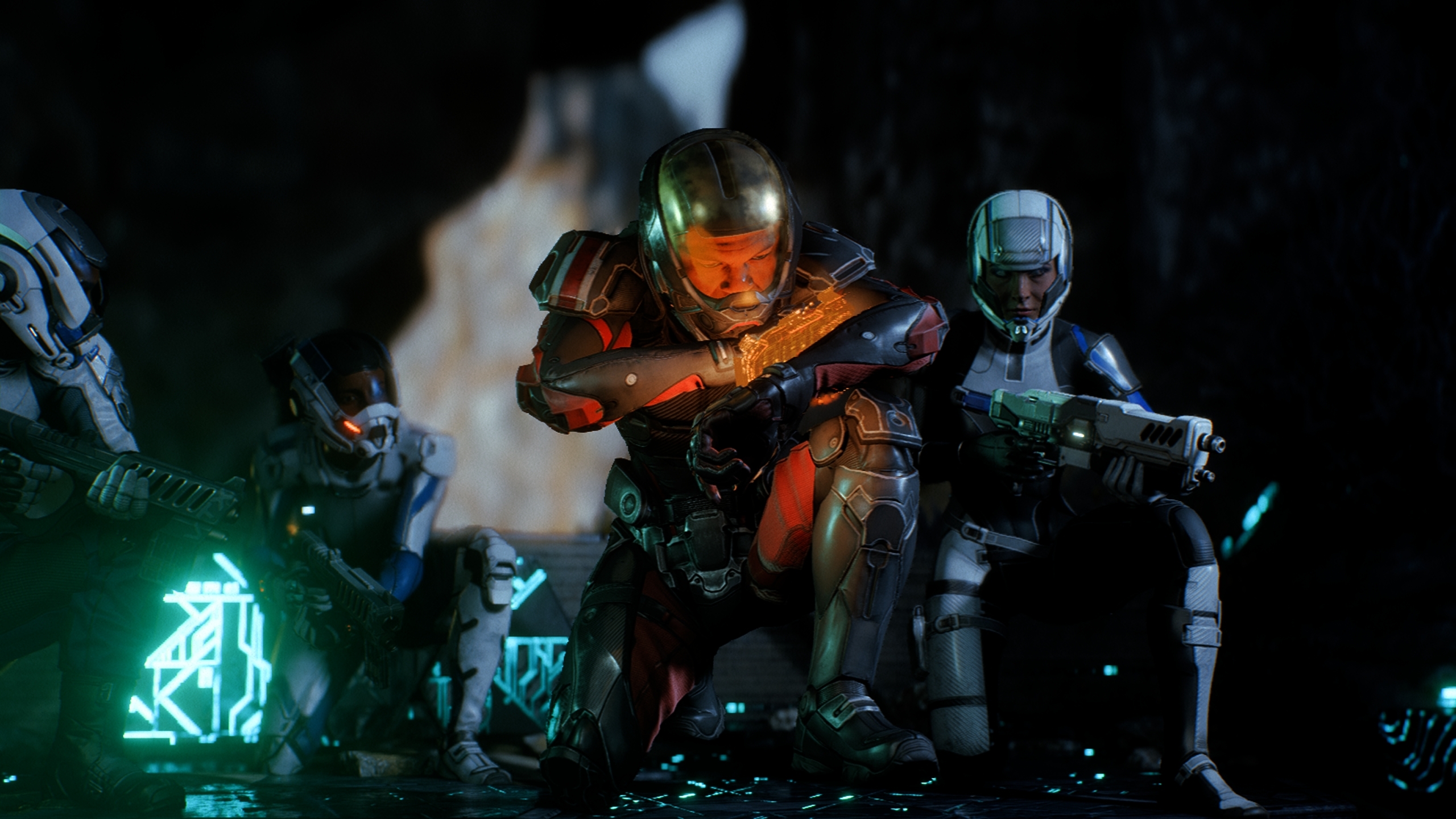
To keep things relatively simple for testing, I've used four settings/resolution combinations. For entry level hardware, I tested at 1080p medium, but I disabled the resolution scaling. Andromeda by default enables scaling from 900p at the medium preset (and 720p using the low preset, with 1080p at the high preset). It's not a horrible option to have, but on a PC where you can simply set the game to render at a non-native resolution, I'm not sure what the point is, and forcing users to switch to the custom preset to change the scaling option is annoying. For the other three resolutions, 1080p, 1440p, and 4K, I used the ultra preset, which doesn't enable scaling by default.

Jumping into our testing—or at least, repeatedly sprinting around the barren landscape of Eos—1080p medium is a good target for moderate graphics cards. I've tested the GTX 1050, 1050 Ti, and RX 460, but if you're looking for older equivalents, the GTX 950, 960, and R7 370 should be pretty similar. Low-end cards may not be able to handle 1080p ultra with great performance, but 1080p medium is a viable alternative.
Turning off the high quality temporal AA and running FXAA is a painful visual tradeoff, but temporal anti-aliasing does cause a relatively large 10-15 percent performance hit. Even with temporal AA on, the entry level cards run Andromeda pretty well—not 60 fps smooth, but certainly playable.
Above the 1050 Ti, everything easily runs 1080p medium, which means you can bump up a few settings and still run well above 60 fps. The high preset, incidentally, drops framerates by about 40 percent, so most mainstream cards will want to find a balance between the medium and high presets.
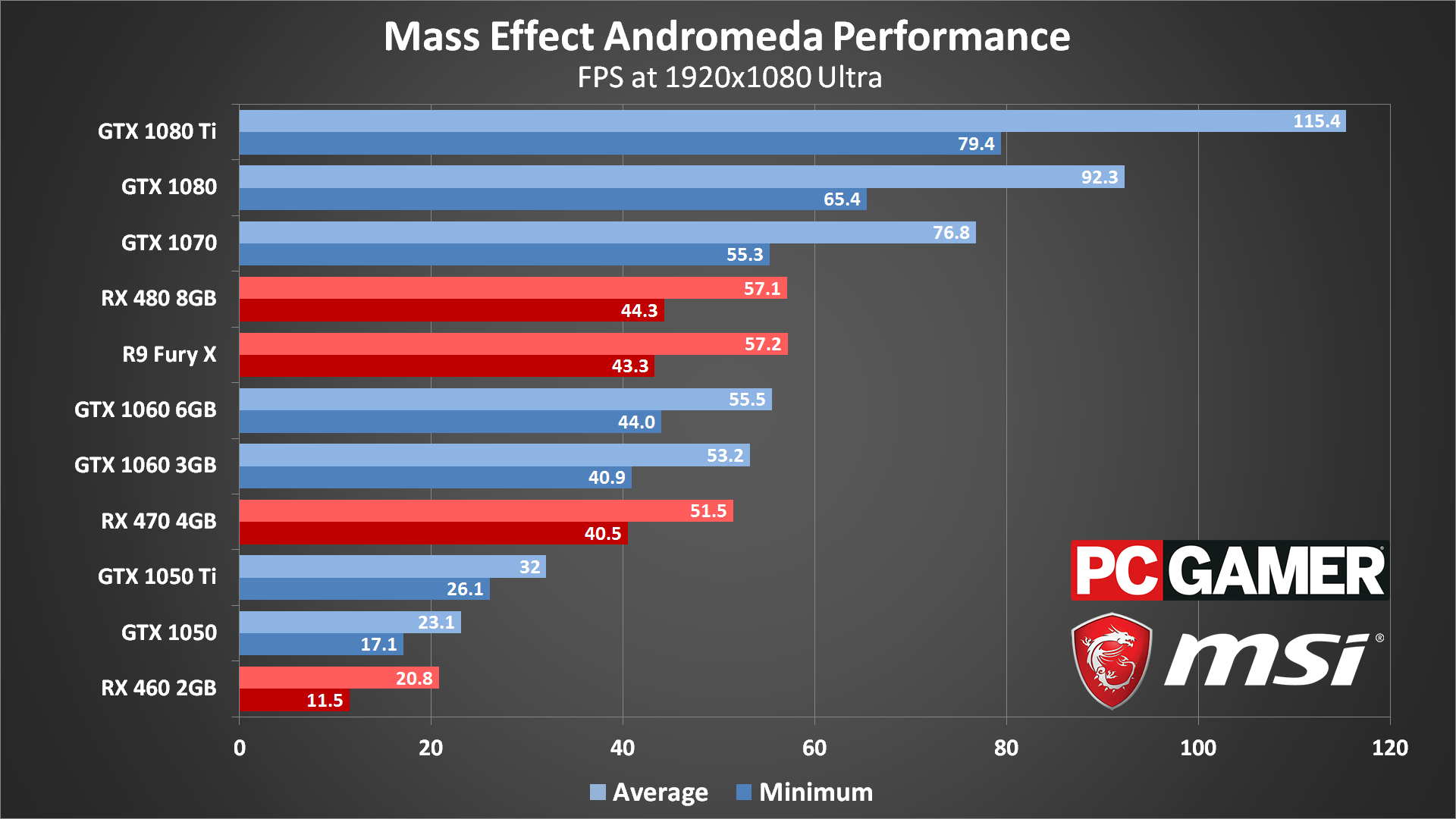
Shooting for 1080p and ultra settings will require a surprisingly high-end card if you want a constant 60 frames per second. The 1060 3GB and 6GB come up just shy of that mark, along with the Radeon 470, 480, and Fury X. In fact, only the 1070 and above from Nvidia will nail 60 fps at 1080p ultra. Previous generation cards like the 980 should be right around the 60 fps mark as well, while the 970 will be closer to 45 fps.
Notice that the current RX series from AMD does substantially better than the previous R9 series. There are several possibilities here. Either it's due to less VRAM, though this doesn't appear to hinder the RX 470 much, or more likely it's due to lower geometry processing capabilities compared to AMD's Polaris GPUs. And I can't rule out driver tuning being focused on the RX series. That doesn't bode well for older AMD cards, but hopefully AMD will improve their performance with a future driver.
While the game does contain shooter elements, I'd also note that 60 fps isn't absolutely required—particularly if you have a G-Sync of FreeSync display. 40 fps and above is definitely playable. Looking at the entry-level cards, you can also see that 2GB VRAM cards struggle with ultra settings in Andromeda. You'll really need at least three gigabytes of VRAM, with a card like the GTX 1060, to get close to 60 fps ultra.
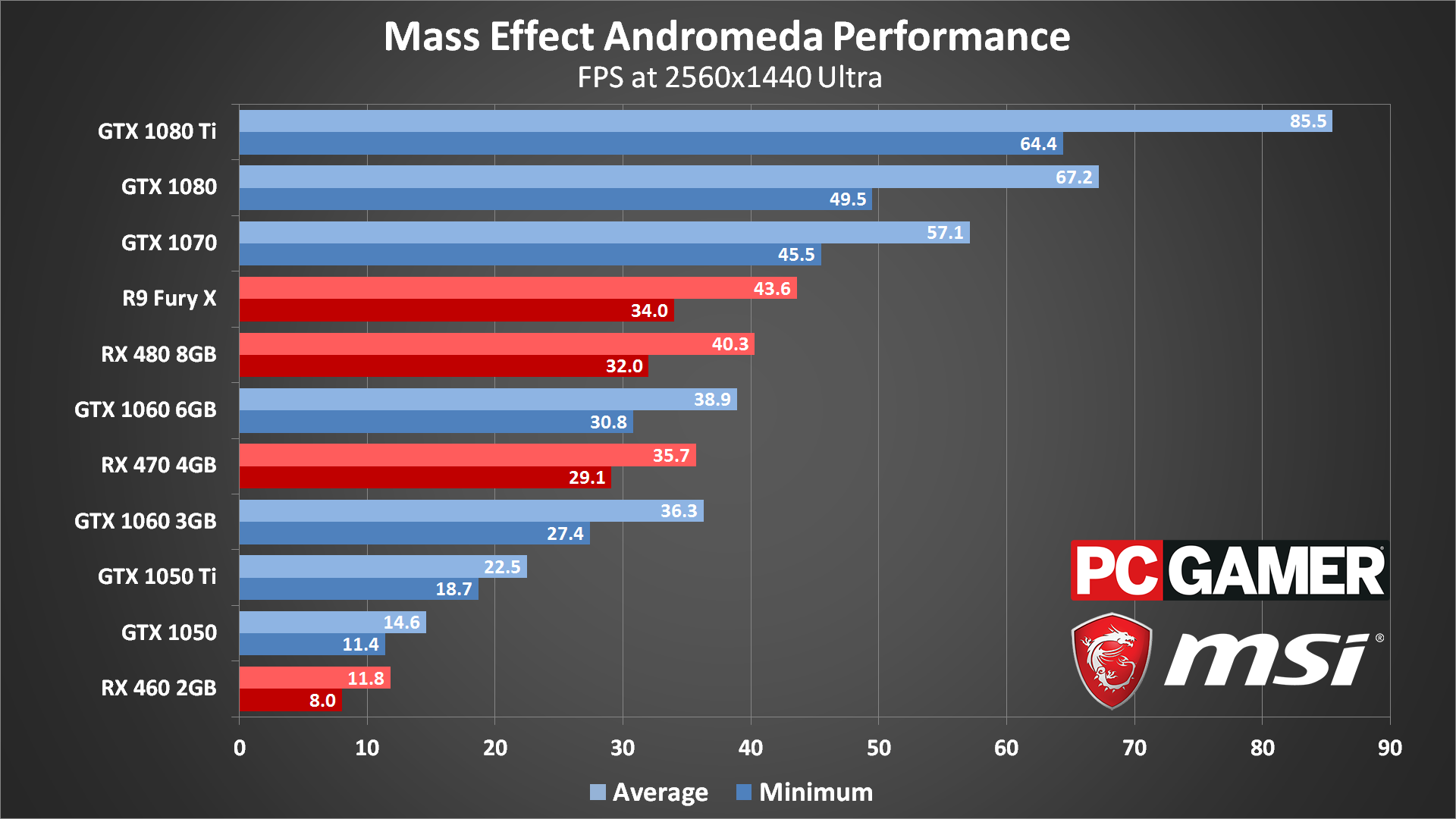
If you have a high-end PC you'll want to crank up the resolution right along with all the bells and whistles. And you'll need a high-end card like the GTX 1080 or 1080 Ti, which are the only two that average more than 60 frames per second at this resolution.
By way of comparison, Battlefield 1 generally gets above 60 fps on everything from GTX 970/1060 3GB or R9 390/RX 470 and up. Of course that also depends on the map and other factors, but overall I've found Andromeda tends to be a bit more demanding than Battlefield 1. That's using the latest drivers along with DX12 (on AMD cards), and as mentioned already there are many less demanding areas of the game where performance will be higher.

And finally, 4K gaming as usual remains an absolute beast. Even the GTX 1080 only gets about 40 fps, and the mighty 1080 Ti still can't get to 60 fps in our benchmark sequence. Dropping to high settings adds another 10 percent in performance, which is just about there—toss in a GPU overclock and you should finally break 60 fps. Or just tweak a few other settings and you'll be fine.
Other cards will have to make much greater compromises on settings if they're going to have a chance at 4K in Mass Effect. But considering the Steam hardware survey says less than three percent of gamers have 1440p or higher resolution displays, the requirements for 4K gaming won't matter to most people.
And if you're hoping to take things to the next level and max out all the settings, that will drop performance another 10 percent or so from ultra quality. You'll need two GPUs in SLI to have a chance at 4K 60 fps in that case, and Nvidia's 378.92 drivers provide that—see below for more on SLI testing. (AMD's latest 17.3.3 drivers also support CrossFire with Mass Effect: Andromeda.)
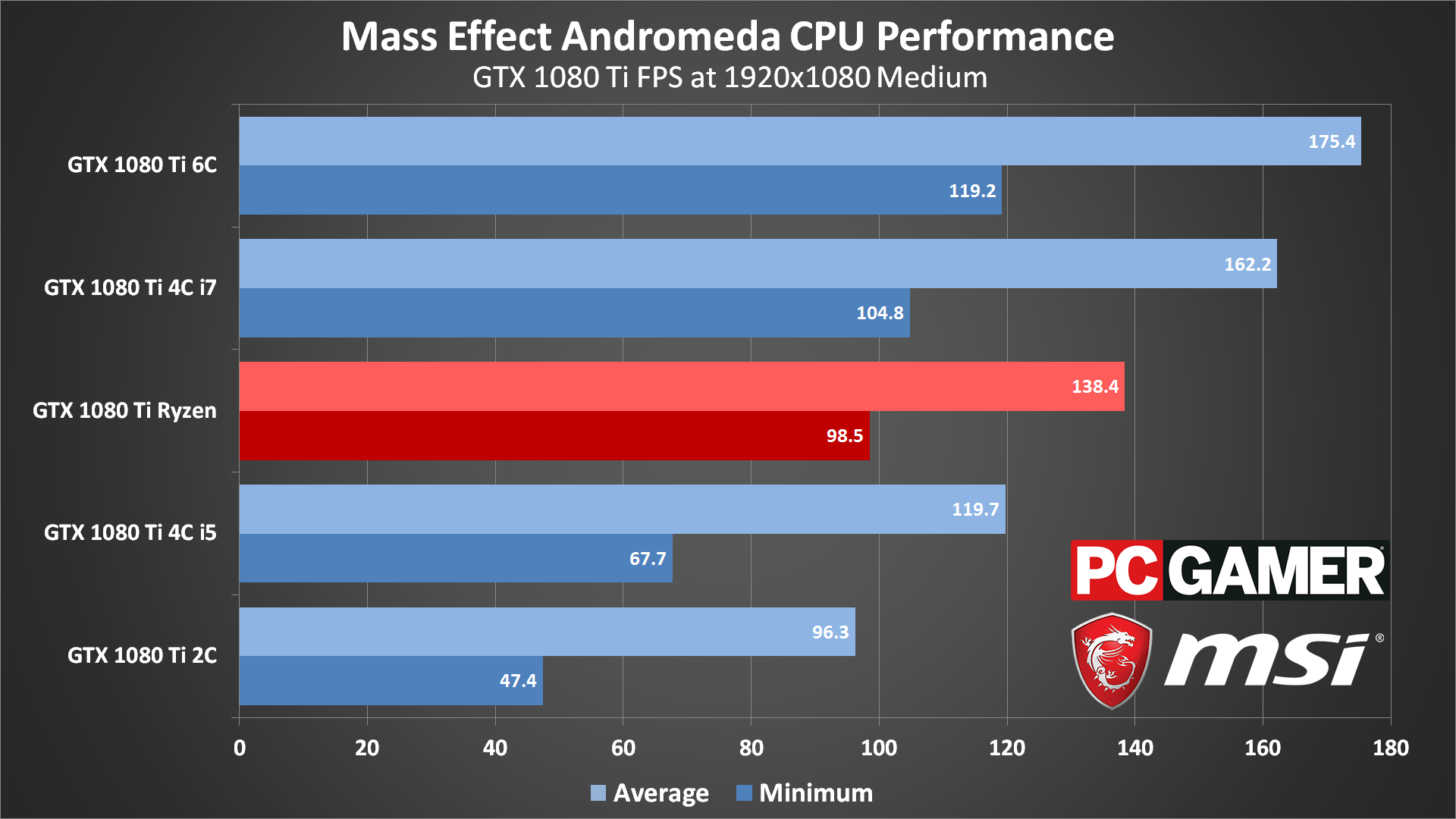
Swipe left/right for more.

Swipe left/right for more.

Swipe left/right for more.
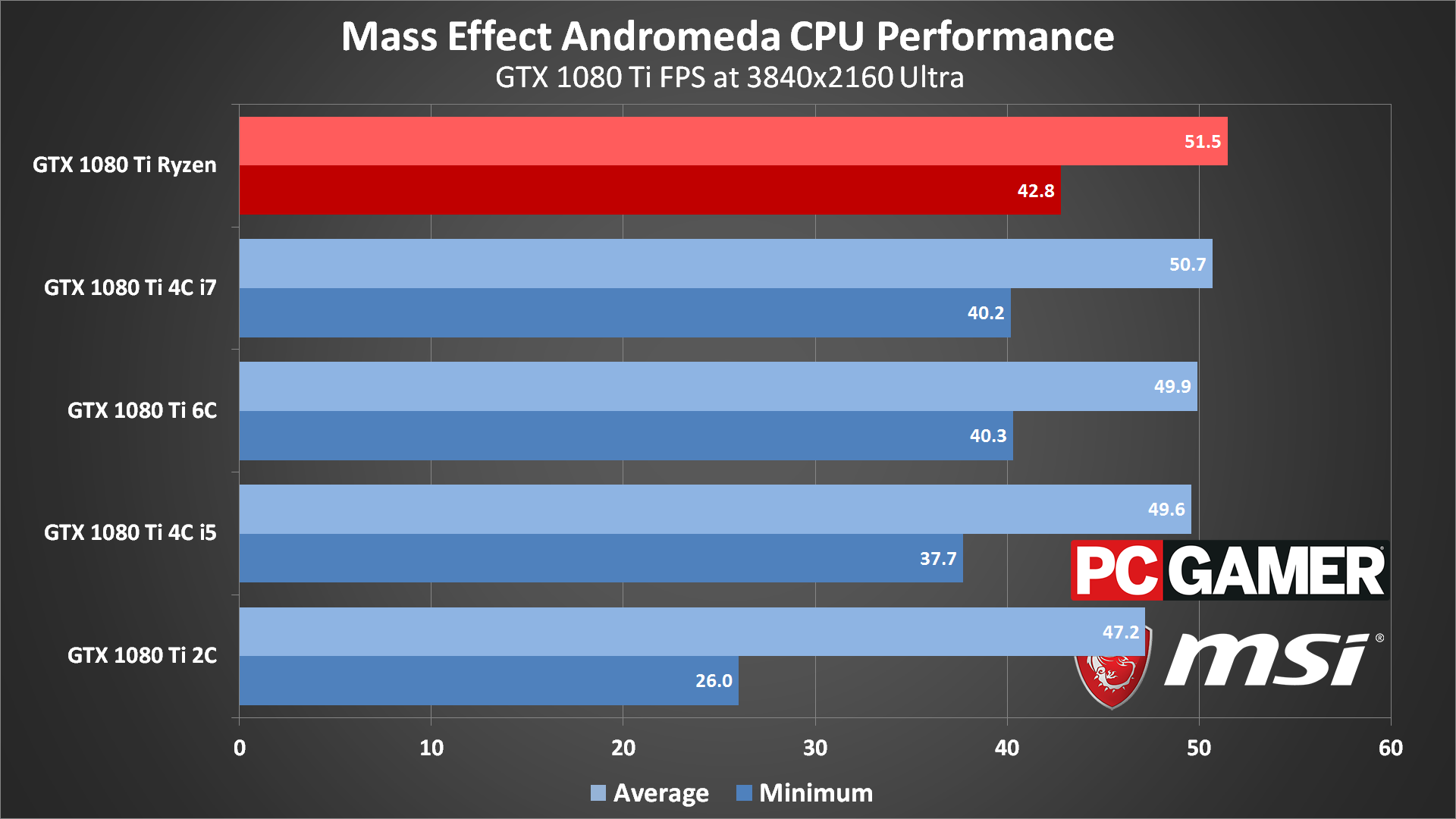
Swipe left/right for more.
Due to the account lock issue, I wasn't able to fully test CPU scaling in advance of the launch, but I have now run the GTX 1080 Ti with a 4.5GHz i7-5930K using all six cores, then again with only four cores (simulating an i7-4790K, more or less), and then one more time with only two cores (i3-7350K estimate). I also ran with four cores but with Hyper-Threading disabled (i5-4690K), and then I tested yet again with a Ryzen 7 1700 overclocked to 3.9GHz.
Looking at CPU scaling, the 4-core i7 is a bit slower at 1080p testing (5-10 percent) compared to the 6-core i7. AMD's overclocked 8-core Ryzen part comes next, with a moderate drop in framerates, followed by the 4-core Core i5. Mass Effect: Andromeda clearly benefits from both CPU clocks as well as core counts (virtual as well as physical). The 4-core i5 shows a significant drop in performance, while using the 2-core setup absolutely tanks performance.
The same pattern is apparent, though not quite as pronounced, at 1080p ultra. Core i5 and above start to group together, but Core i3 is well off the pace. Even 1440p ultra still pegs the i3 way behind, with most of the other parts now running similarly (with better minimum fps on i7 and Ryzen). AMD does claim a win at 4K, which is somewhat interesting to see, while the i3 still shows a minor drop in performance, with far more prominent stuttering.
Minimum fps really takes a hit with 'lesser' CPUs. With a 2-core 4.5GHz Haswell CPU, at 4K the 97 percentile minimum fps is 35 percent lower, and at lower resolutions it's 50-60 percent slower. The overclocked Core i5 chip also hurt overall performance at 1080p, though the difference between it and the Core i7 quad-core (simulated) becomes a lot less noticeable at higher resolutions.
Still, there's a far greater likelihood of stutter with a true quad-core part than with a quad-core plus SMT/Hyper-Threading part. Core i5-4690K users take note. But this is with the fastest GPU around, and things aren't quite so dramatic with lesser graphics cards.
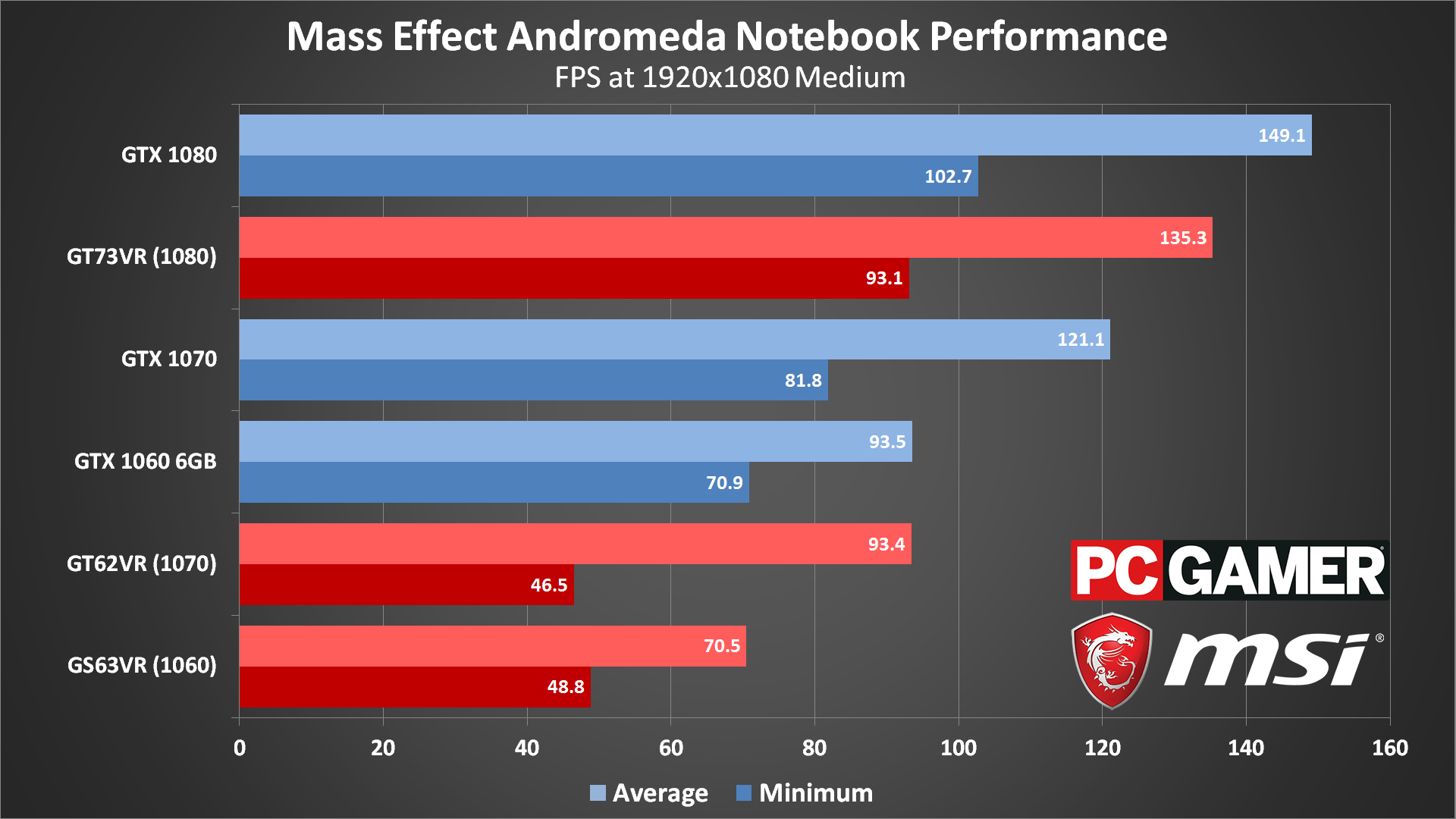
Swipe left/right for more.
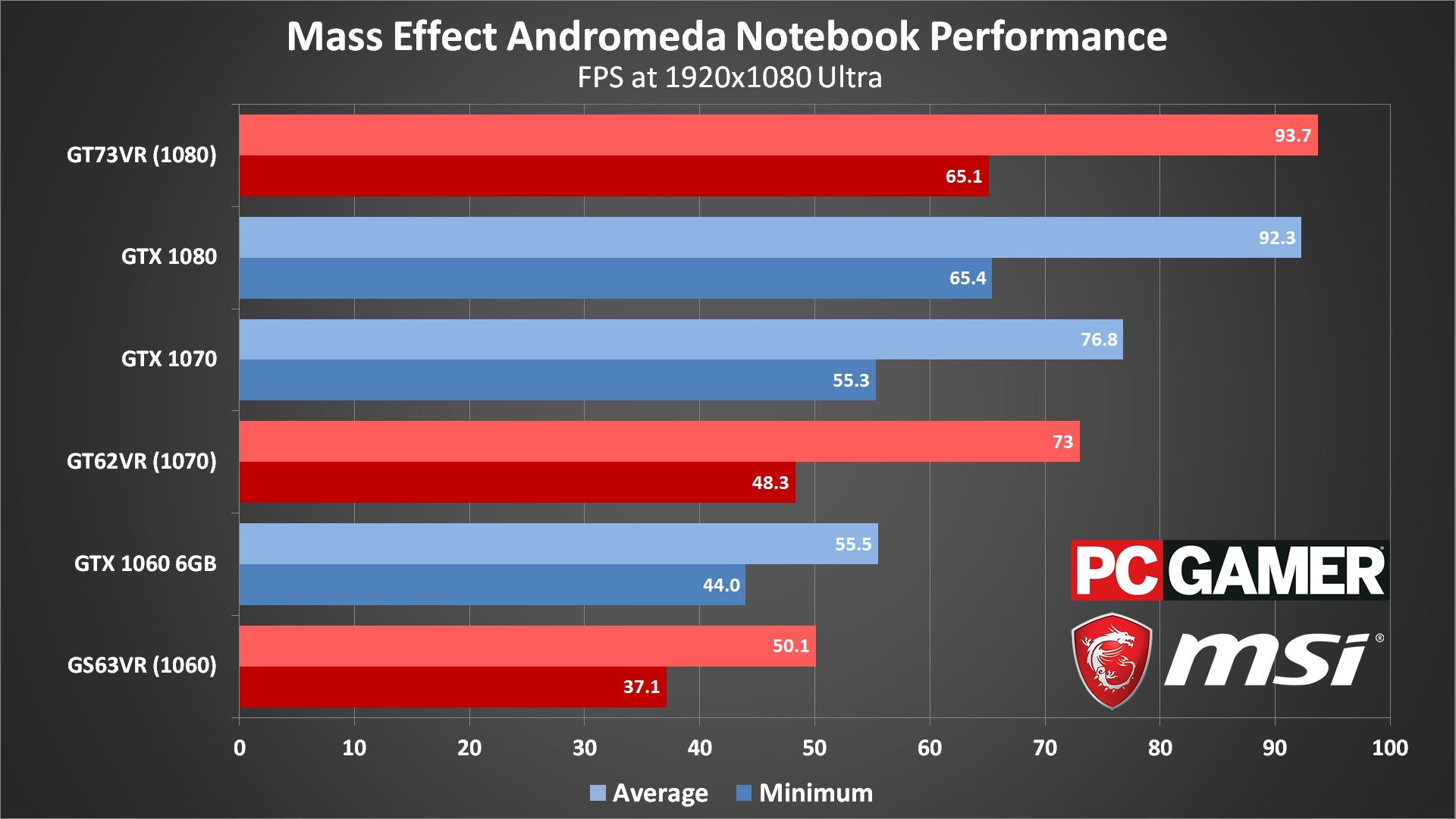
Swipe left/right for more.
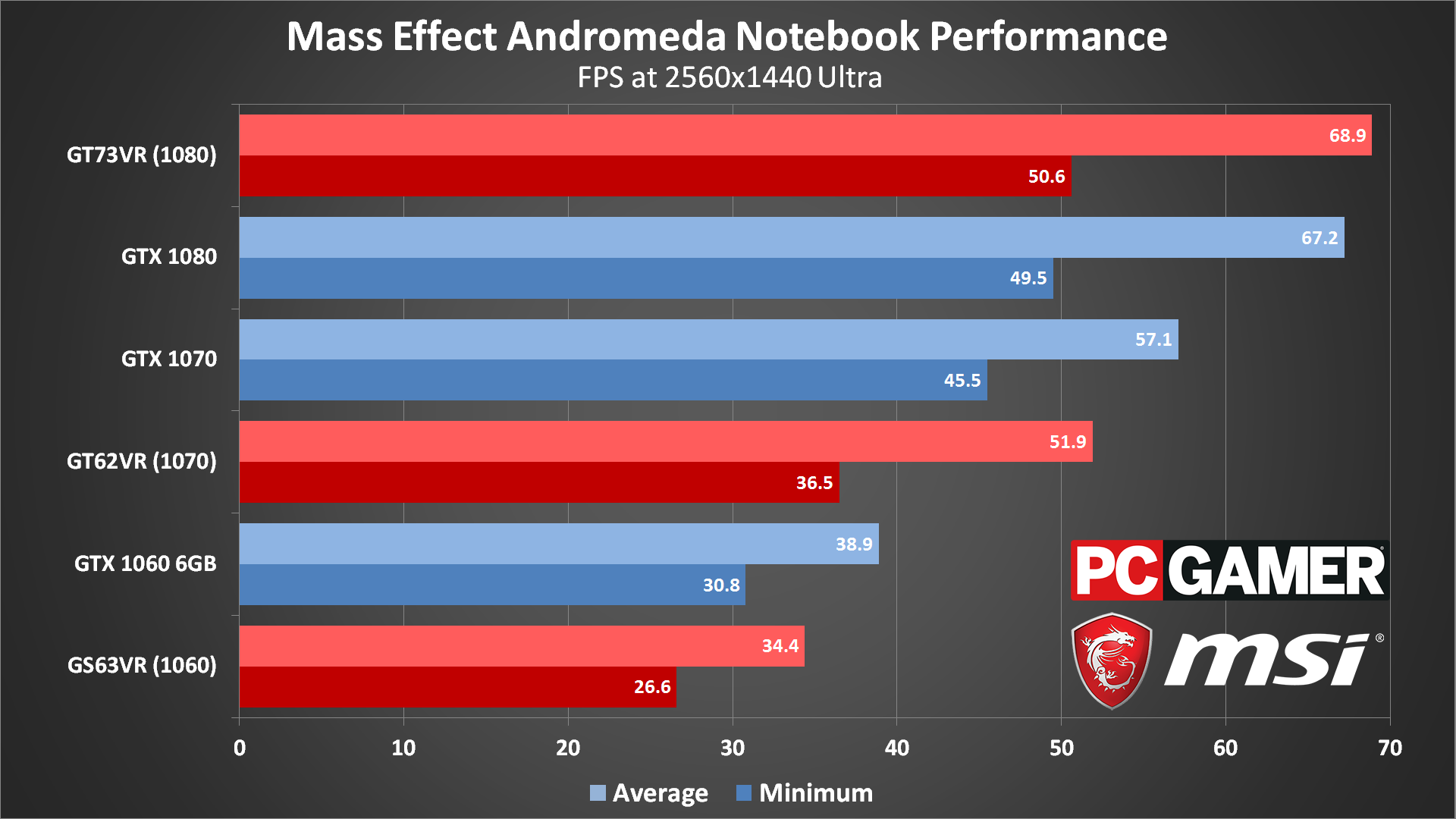
Swipe left/right for more.
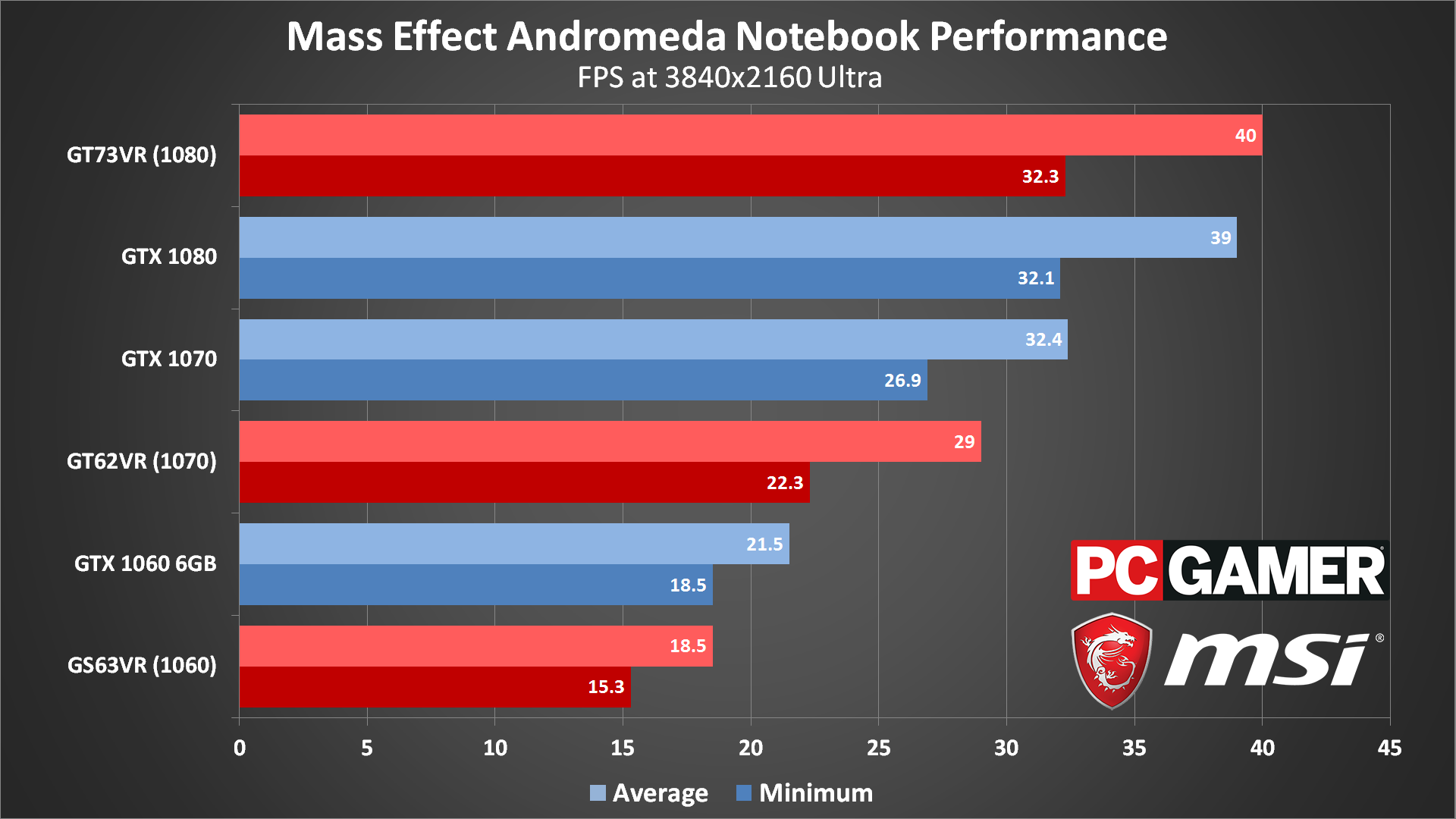
Swipe left/right for more.
And finally, we have gaming notebook performance. I've used MSI's GT73VR, GT62VR, and GS63VR for these tests, which are equipped with GTX 1080, GTX 1070, and GTX 1060 6GB, respectively. The GT73VR actually overclocks the GPU relative to stock mobile 1080, and at higher resolutions the notebook just edges out the desktop 1080 (also overclocked). If you though gaming notebooks were all bluster, think again!
I'm also pleased to report that the GT73VR maintains a reasonable temperature and relatively subdued noise levels even under load. The GT62VR gets a bit louder, while the GS63VR—which is very thin considering the performance level—is very clearly audible. The mobile CPUs prove a bit of a bottleneck at 1080p medium, but I wouldn't worry about it.
You might be wondering about the resolution support, and for the above slides I used DSR on the GT73VR and GT62VR—a nice way to get a bunch of anti-aliasing if you have performance to spare. (Note: I tested the GT73VR both with an external 4K display and DSR, and performance was the same either way.) As an extra bonus, both the GT73VR and GT62VR are available with 120Hz G-Sync displays, which tend to be more useful than 4K on a notebook in my experience.
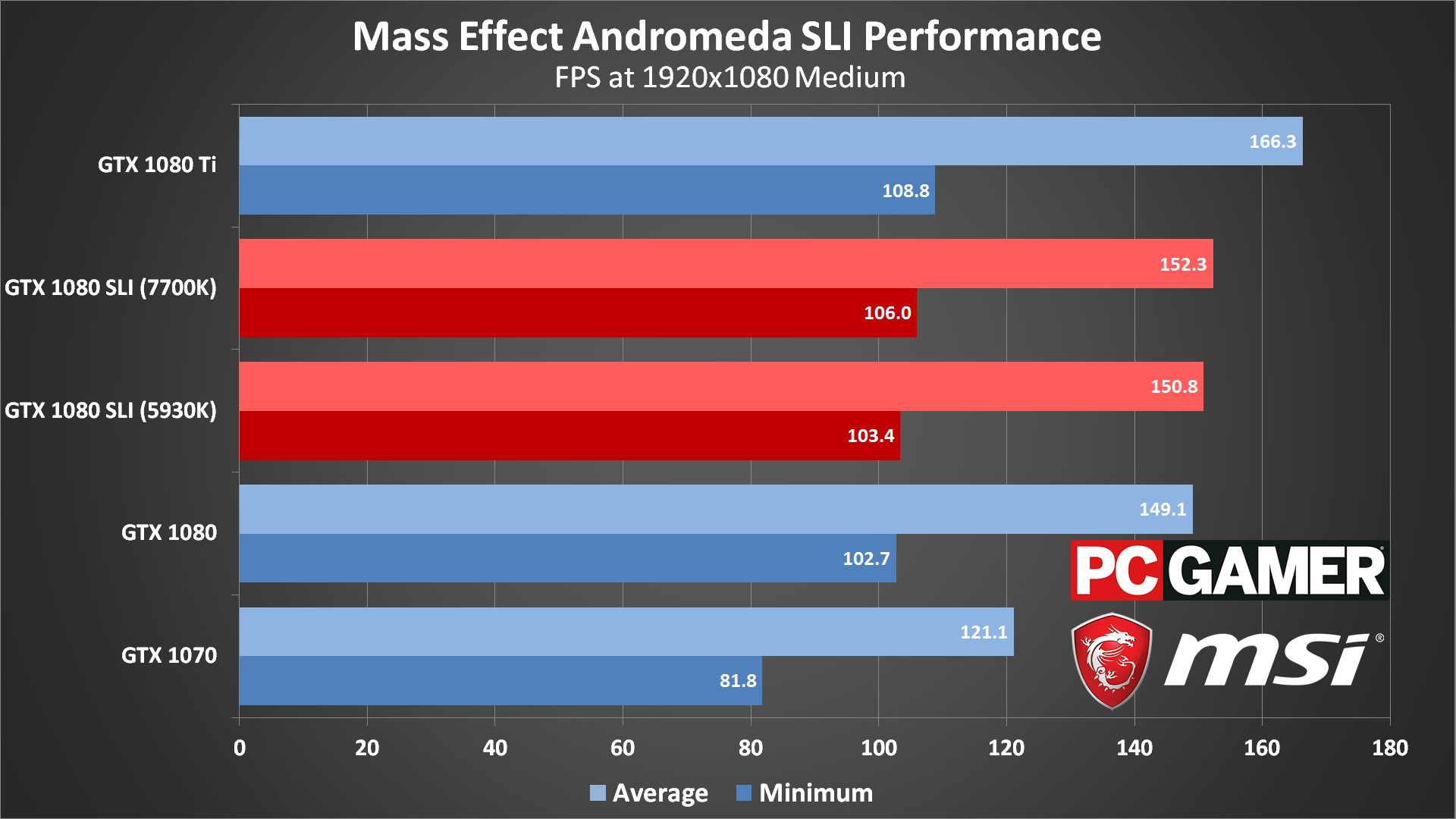
Swipe left/right for more.
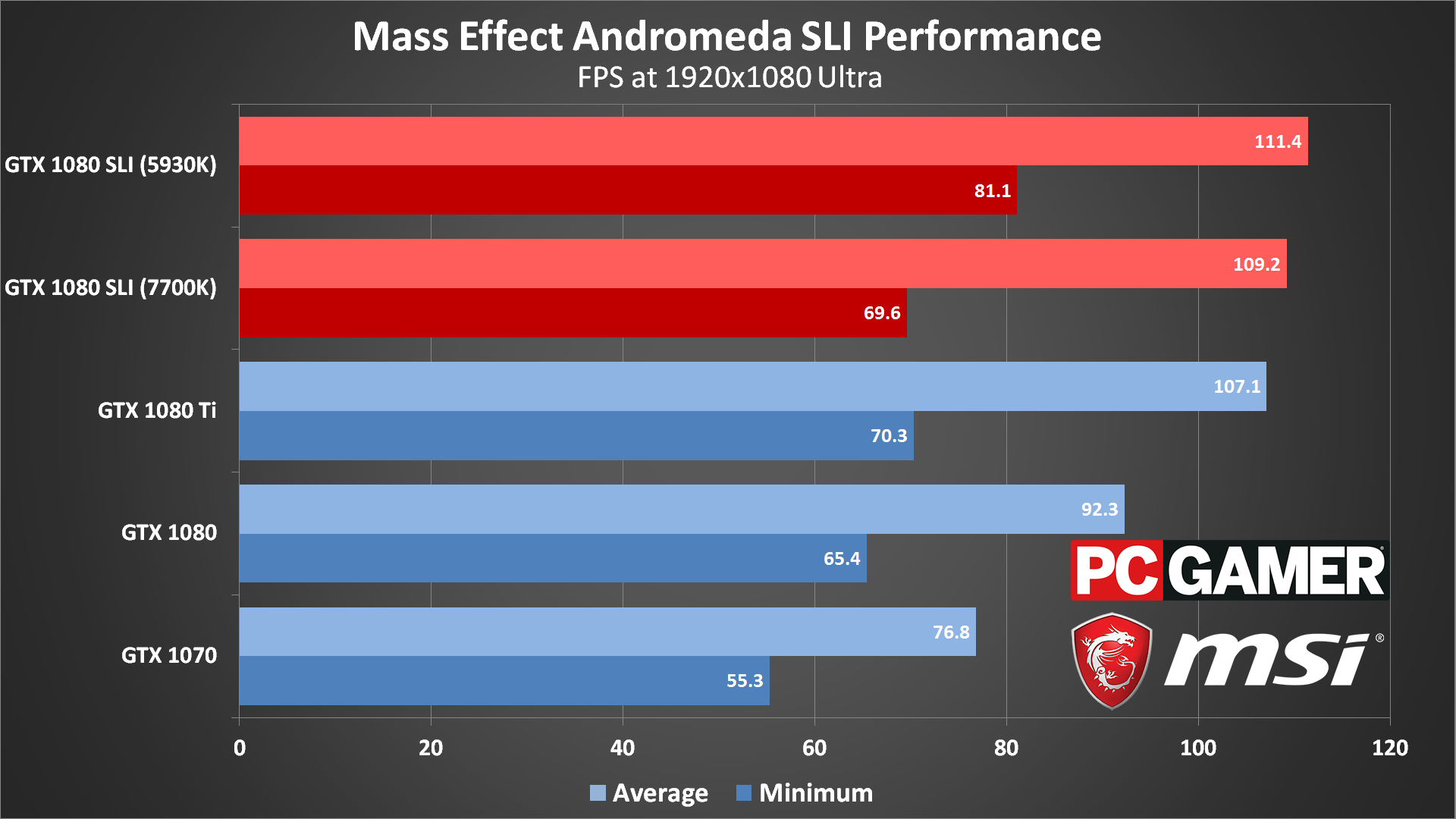
Swipe left/right for more.

Swipe left/right for more.
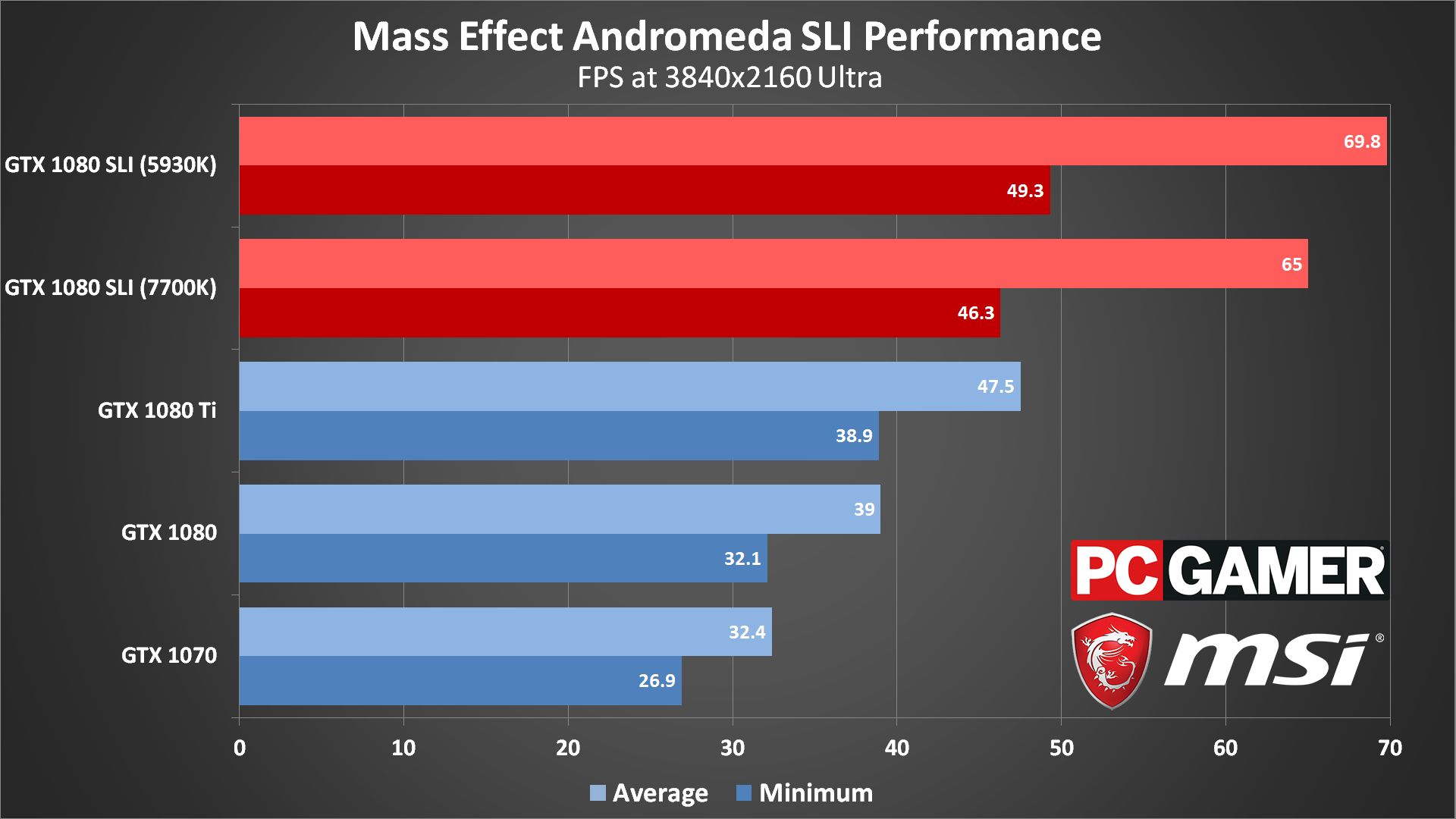
Swipe left/right for more.
And as one final look at performance, I was able to test SLI with two of MSI's GTX 1080 Gaming X 8G cards. I updated the test systems to the 378.92 drivers, as prior to that SLI actually reduced performance substantially vs. a single GPU.
For this test, I also ran the cards in an X99 system (MSI X99A Gaming Pro Carbon plus i7-5930K), to see if the extra PCIe lanes on X99 would make a difference. This is using an HB SLI bridge as well, so that's not a potential bottleneck. The verdict? Yes, except at 1080p medium (which you wouldn't be using with 1080 SLI).
To be clear, it's not a huge boost in performance going from an overclock 7700K to an overclocked 5930K, but minimum fps in particular clearly benefits from the additional PCIe lanes. Interestingly, it's at 4K that the X99 system shows the greatest benefit (percentage-wise), maintaining a 5 fps margin of victory even in what is traditionally a GPU-limited scenario.
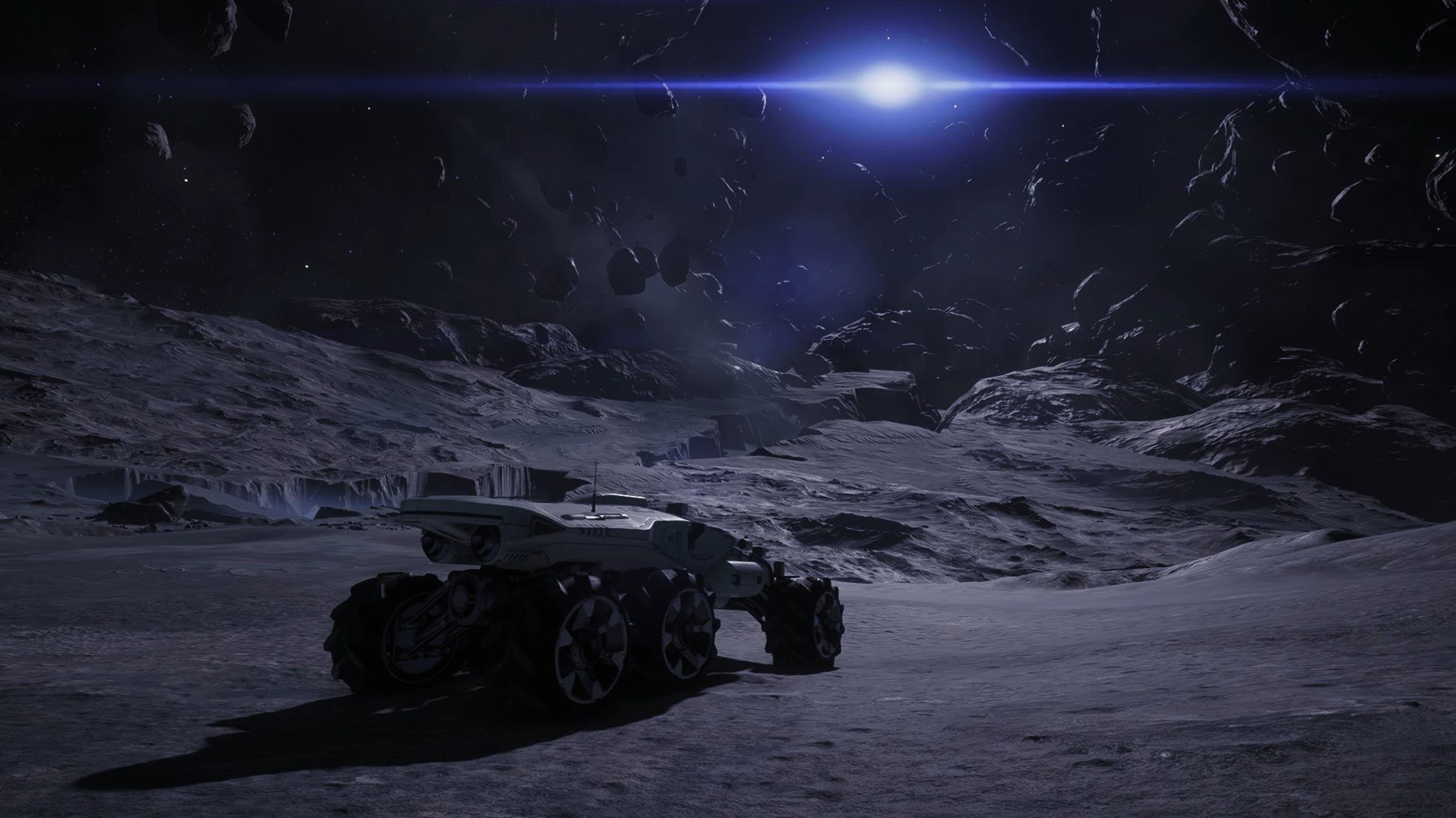
Test System
MSI Aegis Ti3 VR7RE SLI-014US
MSI X370 Xpower Gaming Titanium
Graphics Cards
MSI GTX 1080 Ti FE 11GB
MSI GTX 1080 Gaming X 8G
MSI GTX 1070 Gaming X 8G
MSI GTX 1060 Gaming X 6G
MSI GTX 1060 Gaming X 3G
MSI GTX 1050 Ti Gaming X 4G
MSI GTX 1050 Gaming X 2G
MSI RX 480 Gaming X 8G
MSI RX 470 Gaming X 4G
MSI RX 460 2G OC Gaming
Gaming Notebooks
MSI GT73VR Titan Pro (GTX 1080)
MSI GT62VR Dominator Pro (GTX 1070)
MSI GS63VR Stealth Pro (GTX 1060)
Looking at AMD versus Nvidia GPUs, after the 17.3.2 driver update, AMD performance improved by 10-15 percent on the RX series. That pushes performance of the RX 470 and 480 ahead of Nvidia's 1060 3GB and 6GB cards, making AMD's mainstream GPUs a clearly better value. But without Vega, AMD still can't touch the 1070, let alone the 1080 and 1080 Ti, and the Fury X performance is much lower than I expected. At the high-end of the GPU spectrum, Nvidia's 10-series GPUs reign supreme.
As it stands, Andromeda can be a fairly demanding game, particularly if you're hoping for a steady 60 fps at 1080p or higher resolution and ultra quality. A powerful graphics card is required, but don't skimp on your processor—a Core i3 or older AMD CPU can definitely put the brakes on your experience. PCs with more moderate specs will likely want to look at medium to high quality, but the good news is that high framerates aren't absolutely required to get the most out of Andromeda. 60 fps or more is great to have, but in my experience 30 fps and above is sufficient, though if you're only averaging 30-40 fps you can expect occasional stuttering as the game drops below that level.
Jarred's love of computers dates back to the dark ages when his dad brought home a DOS 2.3 PC and he left his C-64 behind. He eventually built his first custom PC in 1990 with a 286 12MHz, only to discover it was already woefully outdated when Wing Commander was released a few months later. He holds a BS in Computer Science from Brigham Young University and has been working as a tech journalist since 2004, writing for AnandTech, Maximum PC, and PC Gamer. From the first S3 Virge '3D decelerators' to today's GPUs, Jarred keeps up with all the latest graphics trends and is the one to ask about game performance.















